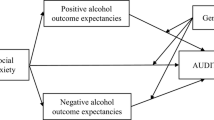Abstract
The purpose of this study was to validate the use of Leigh’s (1990) alcohol sex expectancies scale among HIV-infected individuals presenting for treatment as a way to facilitate research on sexual risk reduction among individuals in that population. The participants were 944 men who presented for treatment at infectious disease or general medicine clinics across 8 different VA Medical Center sites. A total of 534 of these men were HIV-positive and 410 were HIV-negative. The total sample was randomly divided in half within each HIV group to form exploratory (Sample 1) and confirmatory (Sample 2) subsamples. A principal components factor analysis with oblique rotation of the original 13-item Leigh scale within each HIV group in Sample 1 revealed a 2-factor (7 and 4 items, respectively) solution that was consistent across both HIV groups. These factors were named “More Open to Sexual Pleasure” (Factor 1) and “Reduced Inhibitions about Sex (Factor 2).” A confirmatory factor analysis of the 11-item, 2-factor solution on the full Sample 2 showed a modest fit to the data, excellent internal consistency reliability of both factors, a high correlation between the factors, and strong evidence for construct validity. These results were interpreted as supporting the use of the 11-item, 2-factor version of Leigh’s scale in studies of clinical samples of HIV-positive adults, and directions for research on further scale refinement are discussed.
Similar content being viewed by others
References
Babor, T. F., & Grant, M. (Eds.). (1989). Project on the identification and management of alcohol-related problems. Report on phase II: A randomized clinical trial of brief interventions in primary health care. Geneva: World Health Organization.
Brown, S. A., Goldman, M. S., Inn, A., & Anderson, L. R. (1980). Expectations of reinforcement from alcohol: Their domain and relation to drinking patterns. Journal of Consulting and Clinical Psychology, 48, 419–426. doi:10.1037/0022-006X.48.4.419.
Brown, J. L., & Vanable, P. A. (2008). Cognitive-behavioral stress management interventions for persons living with HIV: A review and critique of the literature. Annals of Behavioral Medicine, 35, 26–40.
Bryant, K. J. (2006). Expanding research on the role of alcohol consumption and related risks in the prevention and treatment of HIV/AIDS. Substance Use & Misuse, 41, 1465–1507. doi:10.1080/10826080600846250.
Bush, K., Kivlahan, D. R., McDonnell, M. B., Fihn, S. D., & Bradley, K. A. (1998). The AUDIT alcohol consumption questions: An effective brief screening test for problem drnking. Archives of Internal Medicine, 158, 1789–1795. doi:10.1001/archinte.158.16.1789.
Cook, R. L., McGinnis, K. A., Kraemer, K. L., Gordon, A. J., Conigliaro, J., Maisto, S. A., et al. (2006). Intoxication before risky sexual behavior in male veterans with and without human immunodeficiency virus infection. Medical Care, 44(Sup 2), S31–S36. doi:10.1097/01.mlr.0000223710.35008.d9.
Cooper, M. L. (2002). Alcohol use and risky sexual behavior among college students and youth: Evaluating the evidence. Journal of Studies on Alcohol. Supplement, 14, 101–117.
Fromme, K., Stroot, E. A., & Kaplan, D. (1993). Comprehensive effects of alcohol: Development and psychometric assessment of a new expectancy questionnaire. Psychological Assessment, 5, 19–26. doi:10.1037/1040-3590.5.1.19.
Gerrard, M., Kurlyo, M., & Reis, T. (1991). Self-esteem, erotophobia, and retention of contraception and AIDS information in the classroom. Journal of Applied Social Psychology, 21, 368–379. doi:10.1111/j.1559-1816.1991.tb00525.x.
Gordon, C. S., Forsyth, A. D., & Stall, R. (2005). Prevention interventions with persons living with HIV/AIDS: State of the Science and future directions. AIDS Education and Prevention, 17(Suppl. A), 6–20. doi:10.1521/aeap.17.2.6.58697.
Hurlburt, D. F., Apt, C., & Rabehl, S. C. (1993). Key variables to understanding female sexual satisfaction: An examination of women in nondistressed marriages. Journal of Sex & Marital Therapy, 19, 154–165.
Justice, A. C., Dombrowski, E., Conigliaro, J., Fultz, S. L., Gibson, D., Madenwald, T., et al. (2006). Veterans aging cohort study (VACS): Overview and description. Medical Care, 44(Suppl. 2), S13–S24. doi:10.1097/01.mlr.0000223741.02074.66.
Kalichman, S. C., Weinhardt, L. S., DiFonzo, K., Austin, J., & Luke, W. (2002). Sensation seeking and alcohol use as markers of sexual transmission risk behavior in HIV-positive men. Annals of Behavioral Medicine, 24, 229–235. doi:10.1207/S15324796ABM2403_08.
Leigh, B. C. (1990). Alcohol expectancies and reasons for drinking: Comments from a study of sexual experiences. Psychology of Addictive Behaviors, 4, 91–96.
Mosher, D. L. (1998). Guilt and sexuality in adolescents. In J. Bybee (Ed.), Guilt in children (pp. 157–184). San Diego: Academic Press.
Rohsenow, D. J. (1983). Drinking habits and expectancies about alcohol’s effects for self versus others. Journal of Consulting and Clinical Psychology, 51, 752–756. doi:10.1037/0022-006X.51.5.752.
Southwick, L. L., Steele, C. D., & Marlatt, G. A. (1981). Alcohol-related expectancies: Defined by phase of intoxication and drinking experience. Journal of Consulting and Clinical Psychology, 49, 713–721. doi:10.1037/0022-006X.49.5.713.
Weinhardt, L. S., & Carey, M. P. (2001). Does alcohol lead to risk behavior? Findings from event-level research. Annual Review of Sex Research, 12, 125–157.
Acknowledgement
This research was supported by the National Institute on Alcohol Abuse and Alcoholism grant U10 AA13566.
Author information
Authors and Affiliations
Corresponding author
Rights and permissions
About this article
Cite this article
Maisto, S.A., McGinnis, K., Cook, R. et al. Factor Structure of Leigh’s (1990) Alcohol Sex Expectancies Scale in Individuals in Treatment for HIV Disease. AIDS Behav 14, 174–180 (2010). https://doi.org/10.1007/s10461-008-9457-2
Received:
Accepted:
Published:
Issue Date:
DOI: https://doi.org/10.1007/s10461-008-9457-2




